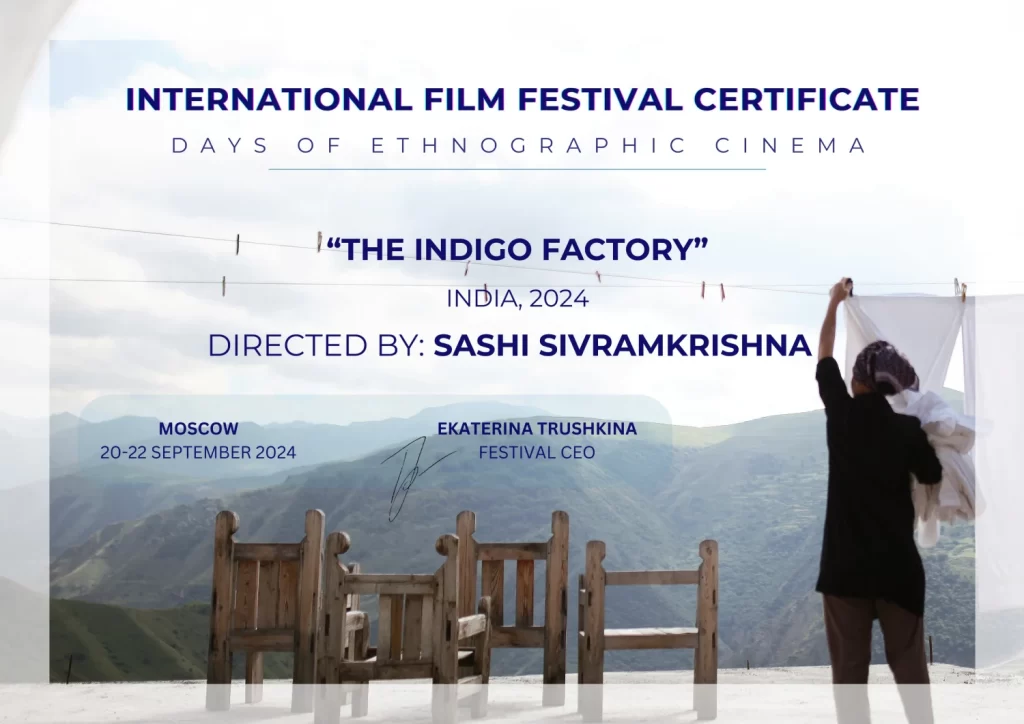An ethnographical and historical narrative on the colour that changed the course of history
Indigo
The Project
Review
I watched the documentary. It is very well made. Congratulations!
Apart from the process of making indigo, the labour that underlies every stage of commodity production is powerfully depicted. Coming to think of it, it is curious as to how the harvesting was by women and the manufacture was handled by men. I wonder if there is a broader statement here about how labour continues to be gendered.
The footage is evocative and the sound recording is of very high quality. This is usually not the case with many ‘social commentary’ documentaries that tend to be rather tedious. The use of the rhythmic cadence of the loom and the stomping of water is excellent and very powerful! All of these elements make the documentary very watchable.
I’d have liked to see a bit more of colonial history woven into the narrative but that’s probably not your objective. I have mixed feelings about the factory itself. The motivation for the owners to revive it along the lines of a colonial mode of production is not clear. The discussion of the workers about the very hard labour involved in aerating the indigo water by stomping reminds me of an older episode. In 1942 the board of the All-India Village Industries Association (run by J. C. Kumarappa) voted to allow the use of electrical power in paper pulp manufacture. I’ve attached an excerpt from my Kumarappa biography and the relevant article from Harijan that you might find of some interest.
Venu Madhav Govindu
Author, The Web of Freedom: J. C. Kumarappa and Gandhi’s Struggle for Economic Justice (OUP, India).
Screenings

Credits
Our special thanks to
- MOHAMMED AYUB, DADA INDIGO, VENGANTHUR
- PRASANNA & RUDRAPPA D.B., CHARAKA, HONNESARA, SAGARA
- SUBBAIAH NAIDU, SRI KIRAN DYEING, BANGALORE
- KIRUBA SHANKAR, VAKASANA, RETTANAI
Dada Indigo
- MUNIYANDI
- KASHI KUMAR
- KAMALA KANNAN
- SALEMBARASAN
- SHANGENI
- ELANGOVAN
- PANCHANATHAN
- BHAGAVAN
Charaka
- HUCHESH
- RAMYA
- GANESH
- VIDYA
- GAYANA
- SUSHMA
- LEELVATI
- MALATI
- SHARADA
Directed by
SASHI SIVRAMKRISHNA
Cinematography & Directorial Assistance
SANDEEP P. KUMAR
Project Field Researchers
SHIVA M
Narration
OSHADHA P
Editor & Digital Colorist
RANJAN NAG
Still Photo Editing
JIJEESH T
Camera Assistants & Sound Recordists
RAJA
Sound Design
ANAND VEYATTUMMAL
Archival Photographs
JEAN BAPTISTE OSCAR MALLITTE
(ALLAHABAD, 1877)
PRODUCED BY
FOUNDATION TO AID INDUSTRY RECOVERY INDIA
















